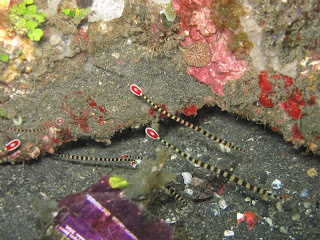
Whenever you read of the “best” dive location, there's usually a fair bit of debate – for example, some divers prefer reefs with small fish, while others prefer big fish, big current, wrecks, or underwater caves. Even in these categories, there's probably quite polarised opinions on, say, the best wreck. But when it comes to “muck diving” – which is diving on a sandy/muddy bottom looking for small creatures in the muck – Lembeh is an undisputed king. Perhaps that may be because enthusiasm for muck diving is new – diving in Lembeh was not even mentioned in a 2000 edition of Lonely Planet Indonesia. But the place we stayed at (Two Fish Divers) was full of people who were coming back. One Dutchman was making his fifth trip!
After four days of putting our faces in the Lembeh muck, I mostly agree with the clichés that promise lots of weird marine life. Again, this may be because one doesn't normally dive in a sandy shipping channel; most of the fish books we reviewed post-dive for identification mentioned that most of what we had seen was “common in Indo-Pacific waters from S Japan to N Australia”. But what I really enjoyed about Lembeh, and perhaps muck-diving in general, was the ability to observe marine life for much longer than reef fish, which tend to dart away. This was because the critters in Lembeh typically relied on camoflauge to find food, so most of them were not very mobile. On each dive (which wasn't very deep, so it was possible to stay down for 90 minutes or so), we just hovered right above the sand, waiting until something caught our eye.
The ease at which it was possible to approach marine life made it quite easy to get pictures of the highlights:
 The Flamboyant Cuttlefish pulses white, yellow & purple colours as you get near, then blends into the sand as you retreat.
The Flamboyant Cuttlefish pulses white, yellow & purple colours as you get near, then blends into the sand as you retreat.  The Hairy Frogfish looks just like a volcanic rock with algae all over it.
The Hairy Frogfish looks just like a volcanic rock with algae all over it.
.JPG) Small, very colourful, frogfish also lurk amongst the algae – some of the most enjoyable moments in Lembeh are just watching these little fish waddle in the sand to find the best hiding spot in the algae.
Small, very colourful, frogfish also lurk amongst the algae – some of the most enjoyable moments in Lembeh are just watching these little fish waddle in the sand to find the best hiding spot in the algae.
 Nudibranchs are quite common in Lembeh – some of them, like this ceratosoma species, disguise themselves like a frogfish.
Nudibranchs are quite common in Lembeh – some of them, like this ceratosoma species, disguise themselves like a frogfish.
 A school of banded pipefish, swimming alongside some Lembeh litter, which often acts like an artifical reef. Indeed, the most common homes for reef octopi were old bottles (below).
A school of banded pipefish, swimming alongside some Lembeh litter, which often acts like an artifical reef. Indeed, the most common homes for reef octopi were old bottles (below).







